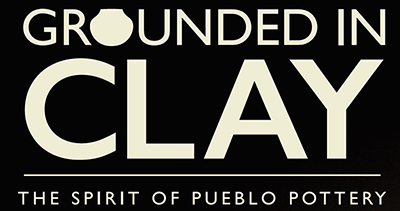Tazbah Gaussoin
Picuris Pueblo, Diné/Navajo
Curator Tazbah Gaussoin (Picuris Pueblo, Diné/Navajo) is an artist and a museum technician in collections management.
Tazbah chose the following for the Grounded in Clay exhibit:
Pin,wel mo lo mõ
The piece I chose is a Pin,wel mo lo mõ¹ that was made around the turn of the twentieth century. When I selected this pot from the SAR collection, I imagined the master potter who made it and what their surroundings might have been like. It made me curious about the similarities and differences between Picuris Pueblo at that time and in the present day. I am drawn to this vessel because of its previous use as a storage jar, and how it might once have held food that provided nourishment for our community.
I am also drawn to it because of the designs made by the artist. As I have been told, the dark spots or ash plumes are intentionally made by the artist during the firing process. The clay and mica used in this pot are from my home of Picuris Pueblo. Our ancestors used a mica “paint” on the lower stories of adobe homes, similar to the mica slip that is sometimes used in the pottery-making process. I value this connection between our micaceous pottery, which Picuris is best known for, and our homes. The adobe houses were once eight or nine stories high, but were destroyed by cannon fire in a Spanish retaliation after the Pueblo Revolt of 1680.
Clay has a particular importance to me. I have always been taught by my family that the land you come from is precious, and that you should show it respect; if you take care of the land, it will provide for you. As I write this, I am living on the East Coast. Living away from the land and community that molded me can be challenging at times, but I know that my return home will help me feel grounded and, in a sense, rebalanced. I have not learned how to make pottery, but I grew up surrounded by master artists, including those in my own family, and I was encouraged to “play” with all sorts of materials; clay was one of them. The feeling of having earth in my hands is truly grounding. Some of my earliest memories are of playing outside and mixing clay for molding figures and mud pies, and making coils for small pots in my family’s studio. As I continue my education and career in the museum field and learn more about the process of making pottery, so my knowledge of and respect for these master Indigenous artists grow.
A Picuris potter created this jar with the intention of storing food to nourish our community. Although the vessel is no longer used for its original purpose, it is still providing sustenance of a different kind through a continuation of teachings about our culture.
¹ Picuris Pueblo pottery.

